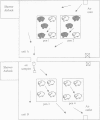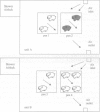Abstract
In order to demonstrate the possible role of aerosol in the transmission of Actinobacillus pleuropneumoniae, an experiment including 18 specific pathogen-free (SPF), 10-week-old piglets, randomly distributed into 2 adjacent units, was carried out. In these facilities, air was forced through absolute filters to prevent any contact with infectious agents. During the first 6 d post inoculation, the 2 units were connected by a rectangular opening and the air circulation was forced by the ventilation system from unit A (inoculated pigs) to unit B (non-inoculated pigs). The A. pleuropneumoniae strain (biovar 1 serovar 9) was isolated in France from an outbreak of porcine pleuropneumonia. Two different infecting doses, 10(7) cfu/animal and 10(8) cfu/animal, were inoculated by intranasal route in 6 pigs of unit A. The infection spread quickly from the inoculated pigs to the non-inoculated pigs. Clinical signs were acute during the 4 d post inoculation: hyperthermia, respiratory distress and, sometimes, death (6 pigs of the unit A and 2 pigs of the unit B). All pigs seroconverted against A. pleuropneumoniae serovar 9 within 2 weeks. Lung lesions were severe: fibrinous pleurisy and lung hemorrhages in the acute stage, pleural adherences and focal pulmonary necrosis in the chronic stage. Actinobacillus pleuropneumoniae was isolated from the tonsils and/or lungs in 16 animals. It could be also isolated from the air of the experimental unit. This study showed that A. pleuropneumoniae was readily transmitted through aerosol over a distance of at least 2.5 m.
Full text
PDF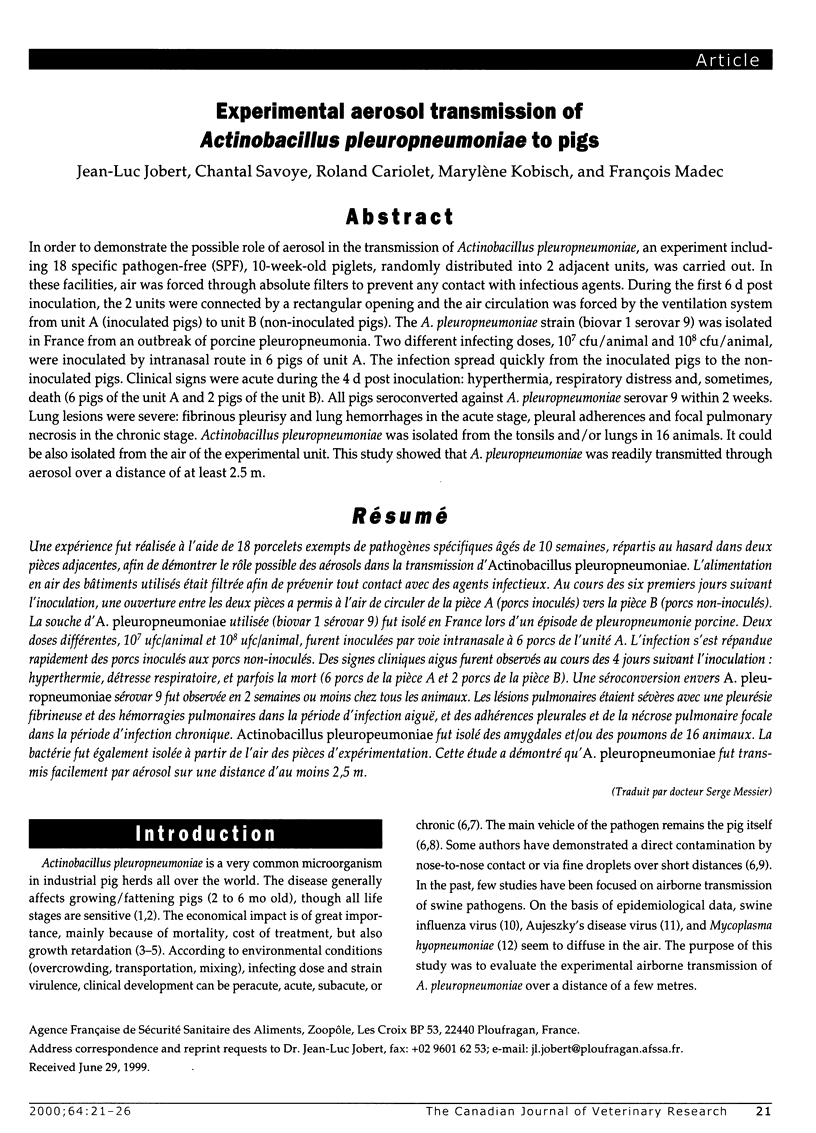

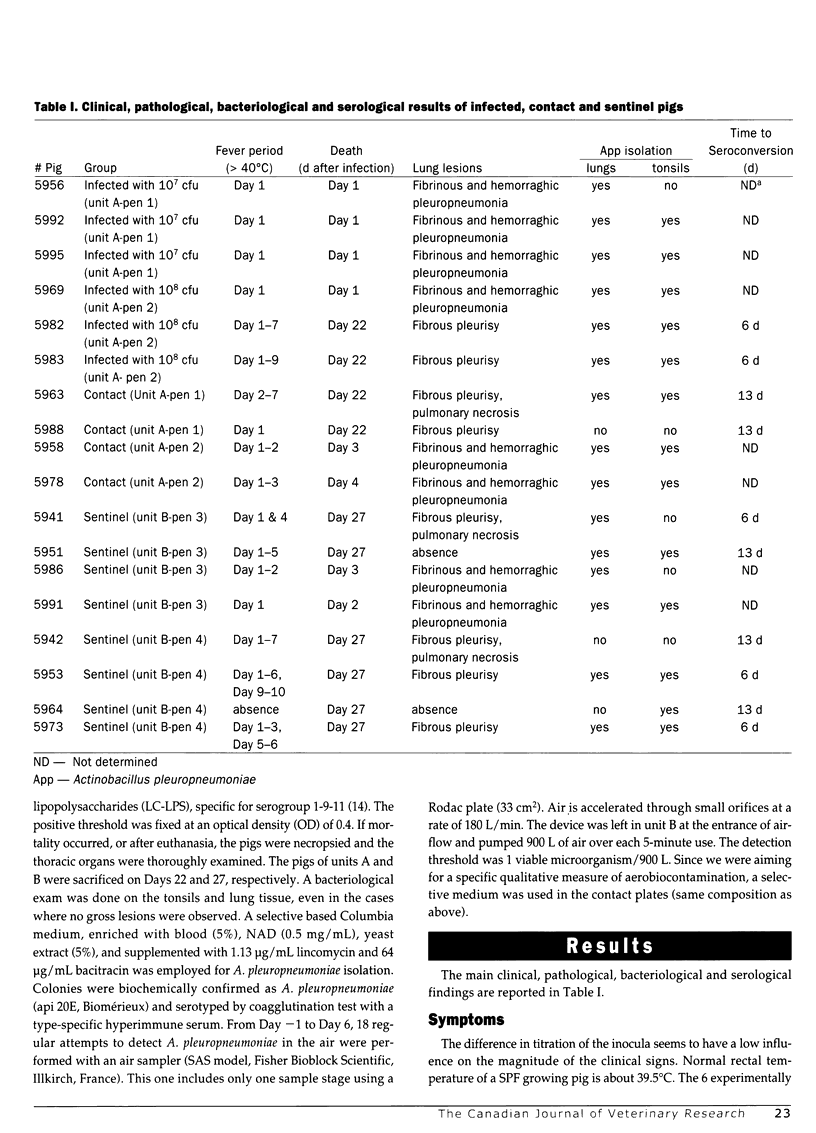
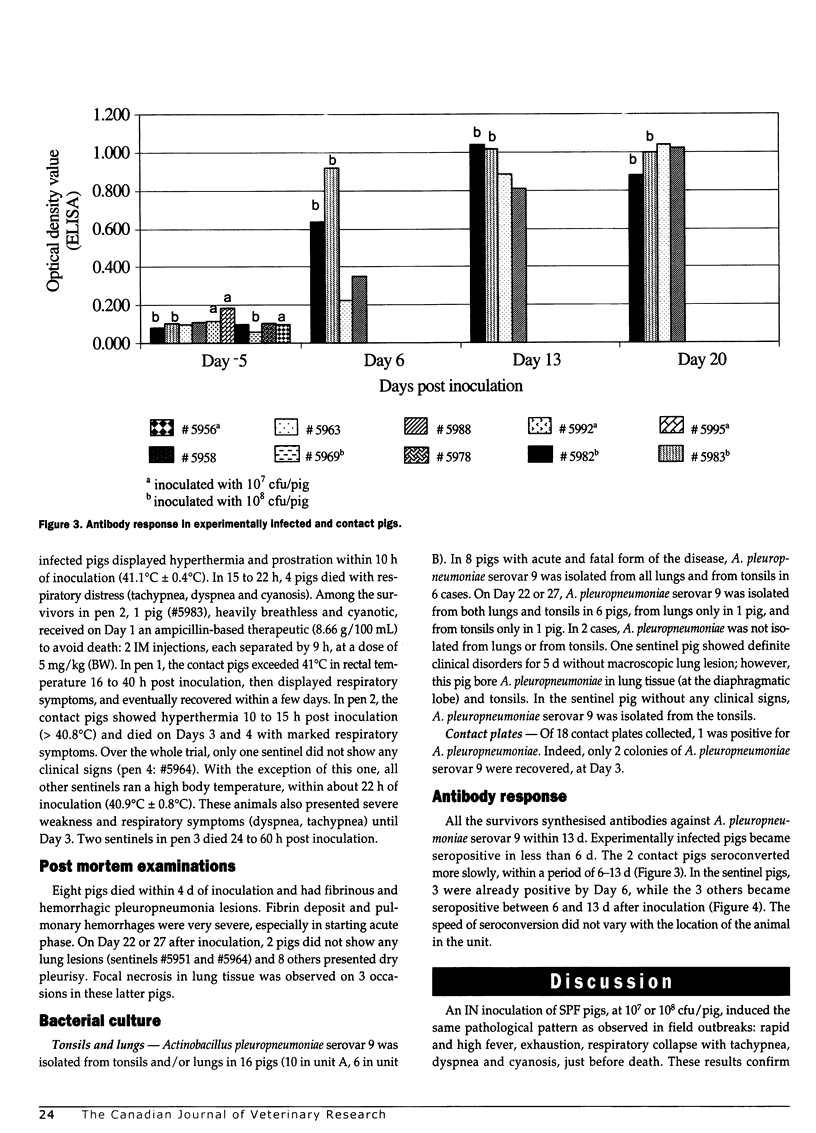

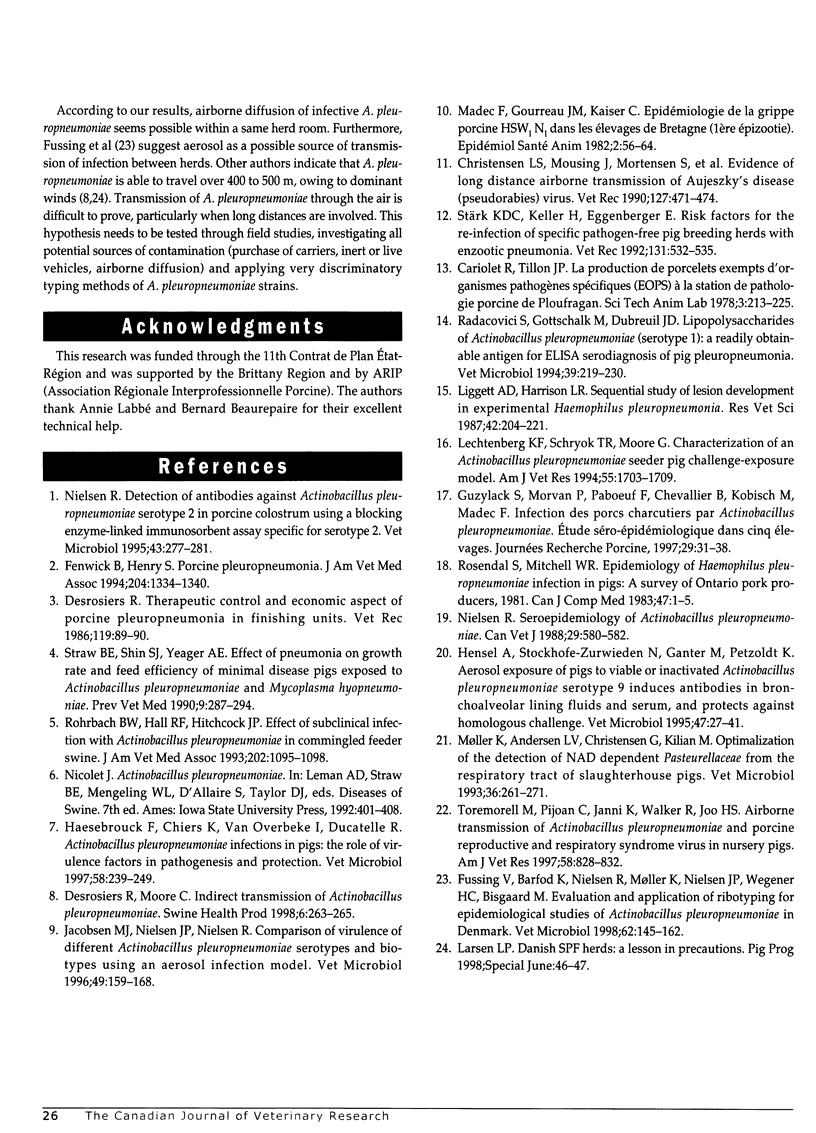
Images in this article
Selected References
These references are in PubMed. This may not be the complete list of references from this article.
- Christensen L. S., Mousing J., Mortensen S., Soerensen K. J., Strandbygaard S. B., Henriksen C. A., Andersen J. B. Evidence of long distance airborne transmission of Aujeszky's disease (pseudorabies) virus. Vet Rec. 1990 Nov 10;127(19):471–474. [PubMed] [Google Scholar]
- Desrosiers R. Therapeutic control and economic aspect of porcine pleuropneumonia in finishing units. Vet Rec. 1986 Jul 26;119(4):89–90. doi: 10.1136/vr.119.4.89. [DOI] [PubMed] [Google Scholar]
- Fenwick B., Henry S. Porcine pleuropneumonia. J Am Vet Med Assoc. 1994 May 1;204(9):1334–1340. [PubMed] [Google Scholar]
- Fussing V., Barfod K., Nielsen R., Møller K., Nielsen J. P., Wegener H. C., Bisgaard M. Evaluation and application of ribotyping for epidemiological studies of Actinobacillus pleuropneumoniae in Denmark. Vet Microbiol. 1998 May;62(2):145–162. doi: 10.1016/s0378-1135(98)00205-3. [DOI] [PubMed] [Google Scholar]
- Haesebrouck F., Chiers K., Van Overbeke I., Ducatelle R. Actinobacillus pleuropneumoniae infections in pigs: the role of virulence factors in pathogenesis and protection. Vet Microbiol. 1997 Nov;58(2-4):239–249. doi: 10.1016/s0378-1135(97)00162-4. [DOI] [PubMed] [Google Scholar]
- Jacobsen M. J., Nielsen J. P., Nielsen R. Comparison of virulence of different Actinobacillus pleuropneumoniae serotypes and biotypes using an aerosol infection model. Vet Microbiol. 1996 Apr;49(3-4):159–168. doi: 10.1016/0378-1135(95)00184-0. [DOI] [PubMed] [Google Scholar]
- Lechtenberg K. F., Shryock T. R., Moore G. Characterization of an Actinobacillus pleuropneumoniae seeder pig challenge-exposure model. Am J Vet Res. 1994 Dec;55(12):1703–1709. [PubMed] [Google Scholar]
- Liggett A. D., Harrison L. R., Farrell R. L. Sequential study of lesion development in experimental haemophilus pleuropneumonia. Res Vet Sci. 1987 Mar;42(2):204–212. [PubMed] [Google Scholar]
- Møller K., Andersen L. V., Christensen G., Kilian M. Optimalization of the detection of NAD dependent Pasteurellaceae from the respiratory tract of slaughterhouse pigs. Vet Microbiol. 1993 Sep;36(3-4):261–271. doi: 10.1016/0378-1135(93)90093-m. [DOI] [PubMed] [Google Scholar]
- Nielsen R. Detection of antibodies against Actinobacillus pleuropneumoniae, serotype 2 in porcine colostrum using a blocking enzyme-linked immunosorbent assay specific for serotype 2. Vet Microbiol. 1995 Mar;43(4):277–281. doi: 10.1016/0378-1135(94)00112-a. [DOI] [PubMed] [Google Scholar]
- Nielsen R. Seroepidemiology of Actinobacillus pleuropneumoniae. Can Vet J. 1988 Jul;29(7):580–582. [PMC free article] [PubMed] [Google Scholar]
- Radacovici S., Gottschalk M., Dubreuil J. D. Lipopolysaccharides of Actinobacillus pleuropneumoniae (serotype 1): a readily obtainable antigen for ELISA serodiagnosis of pig pleuropneumonia. Vet Microbiol. 1994 Apr;39(3-4):219–230. doi: 10.1016/0378-1135(94)90159-7. [DOI] [PubMed] [Google Scholar]
- Rohrbach B. W., Hall R. F., Hitchcock J. P. Effect of subclinical infection with Actinobacillus pleuropneumoniae in commingled feeder swine. J Am Vet Med Assoc. 1993 Apr 1;202(7):1095–1098. [PubMed] [Google Scholar]
- Rosendal S., Mitchell W. R. Epidemiology of Haemophilus pleuropneumoniae infection in pigs: a survey of Ontario Pork Producers, 1981. Can J Comp Med. 1983 Jan;47(1):1–5. [PMC free article] [PubMed] [Google Scholar]
- Stärk K. D., Keller H., Eggenberger E. Risk factors for the reinfection of specific pathogen-free pig breeding herds with enzootic pneumonia. Vet Rec. 1992 Dec 5;131(23):532–535. [PubMed] [Google Scholar]
- Torremorell M., Pijoan C., Janni K., Walker R., Joo H. S. Airborne transmission of Actinobacillus pleuropneumoniae and porcine reproductive and respiratory syndrome virus in nursery pigs. Am J Vet Res. 1997 Aug;58(8):828–832. [PubMed] [Google Scholar]



